As we approach the hottest summer portion, people desire to learn to keep their homes as cool as possible without wasting so much money on electricity bills. Various roofing factors can influence the heat amount absorbed or thrown off your property.
The shelter that absorbs heat can help to keep your apartment delightfully cool. Constructors 911 says that rooftops that gather heat may be 6 to 8 degrees hotter than the rest of the building. Today we are going to explain the roof types which absorb less heat!
Different Ways That Make Your Roof Absorb Less Heat
The temperature on the top of a traditional blacktop can be more than 50 degrees Fahrenheit hotter than the neighboring air temperature on a hot, bright day. Even in rural and suburban areas, the energy absorbed by a typical tower on a hot day boosts degrees within the house, resulting in higher air conditioning demands. Moreover, it causes more pain for those without air conditioning on hot days.
Here are several methods for lowering the temperature on your top by a few degrees.
-
Use a bitumen membrane with white paint
Because most of our roofs used to be flat and smooth, there are numerous possibilities for reducing heat from the roof. The first option, which combines the best of both worlds, is to use modified bitumen membrane rolls constructed of asphalt or other materials. See Suffolk County Roofing Company for more information on your next roofing project.
The membrane is placed by dissolving the surface where the cool sealant is placed, allowing it to be easily attached to the surface. Although applying white paint to the membrane might help reduce heat and provide the finest protection for your ceiling.
-
Single-ply membrane
When it comes to membranes, another option might be considered to remove heat from the roof more effectively without requiring extra surface coating to improve sun reflection. A single-ply membrane is a factory-made rubber sheet with a specific coating protecting against UV rays.
The single-ply membrane is composed of thermoplastic polyolefin (TPO) and Polyvinyl Chloride (PVC) combinations to minimize total solar reflectance, making it inexpensive to buy and an excellent membrane to lower heat from the sun.
-
Build up Roofing
Built-up Roofing (BUR), which is only used for flat or less inclined rooftops, is a well-known method for reducing heat from the canopy. Using a cluster of pebbles, stones, and many other light-colored marbles with improved sun reflection and covering with bitumen or asphalt and adding an affordable mineral as an insulating shell. Adding more layers to the dome will help to prevent heat loss.
-
Apply cool roof coatings
Cool roof coating is the greatest option for any flat or sloped covering. The use of chemically adjusted coatings on the tent improves the tendency for solar energy reflecting, reducing the amount of thermal conduction that enters the structure.
The most prevalent roof cool coatings are resistive and elastic coating. These chemicals are sprayed to your roof through a sprayer, scraper, sweep, or mopping. The all-over solar reflectivity can be boosted by spraying many layers of these compounds, which helps remove heat from the roof more successfully.
-
Use metal sheets
The slanted rooftops have limited options for heat sealing, but we don’t want someone to be denied the basic right to cool during the scorching warmer months. White painted metal sheets are a great source of roof heat protection since they have a high degree of solar reflectance across the country.
However, because steel is an excellent conductor by nature, the sheet absorbs more heat energy. To alleviate this problem, we can apply cool crown coatings to metal sheets with higher solar reflectivity and less likely to accumulate radiation from strong sunlight.
-
Grow a roof green

Growing your rooftop garden with green grass and potted plants is one of the finest ways to keep the top cool. The green covering protects the house from direct sunshine, while the mud in the flower pots and the ground absorb the most heat. Ensure the roof is appropriately waterproofed to avoid water leaking through the outer walls and causing structural damage.
Conclusion
People have been adopting cool roof techniques such as colored shingles for sloped ceilings, imported pebble laying, and various other methods for reducing heat from the shelter. Roof gardening is one of the most advanced heat-reduction solutions, and it has recently made its way into the market with excellent results.
Finally, it’s critical to select an appropriate top for your property. While shingle color, roofing material, and technology can all affect your home’s temperature, a professional roofer should be able to offset temperature variances through superior construction.



